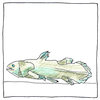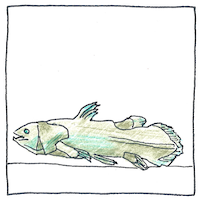Marjorie
Courtenay-Latimer, J.
L. B. Smith
ichthyology

|
Coelacanth
Louis Agassiz described the coelacanth in 1839, thought to have died out in the Upper Cretaceous sixty-five million years ago, but Hendrik Goosen dredged one up from the bottom of the ocean near the Chalumna River, and showed it to Marjorie Courtenay-Latimer, the curator of the local museum, who was forced to have it preserved by a taxidermist. Fish expert J. L. B. Smith was later able to identify it, but Smith hoped, based on its lobbed fins, that the fish was a ancestor of the first land-going four-legged vertebrates, and he could not tell because all the soft parts had been removed by the taxidermist.
A beautiful fish
Large cosmoid scaled, three-lobe tailed, vestigial lunged, the coelacanth, Courtenay-Latimer wrote, “was five foot long, a pale mauvy blue with faint flecks of whitish spots . . . an iridescent silver-blue-green sheen all over. . . . covered in hard scales, and it had four limb-like fins and a strange puppy dog tail.”
Living fossil
O Latimeria chalumnae, you of ancient lineage, you “hollow spine” of Cretaceous fossils O you pale blue fish, you whose scales are armor plates, you whose fins grow from stubby limbs, you whose tail has a tail (your three-lobed diphycercal tail-fin) O you whose brain is mostly filled with fat, whose single-lobed vestigial lung is useless, whose notochord never evolved into a vertebral column, whose heart’s chambers are arranged in a straight tube, whose eyes are big for seeing deep under dark oceans, and whose head is hinged to let you open wide your small mouth Could you tell us all, O fish, How to be both big and maneuverable? How to be lucky in old age? How to survive all the millenniums? Or are you only the silly one, the one we caught? O you exceeding rarity, you scrutiny escaper, you keeper-to-yourself, O great See-lə-kanth.



Frustrated by the lack of soft tissues in Courtenay-Latimer’s taxidermist-preserved coelancanth, Smith was instrumental in organizing a search for a second specimen of the species fourteen years later. The second living species was found in Indonesia in 1998.
It turned out the coelancanth is not the closest known relative of the amphibious tetrapods, the first animals that came up onto land.
Louis Agassiz chose the scientific name for this species, Cœlacanthus, based on its hollow caudal fin rays.
“The coelacanth braincase is 98.5% filled with fat; only 1.5% of the braincase contains brain tissue.”
See also in The book of science:
Readings in wikipedia: